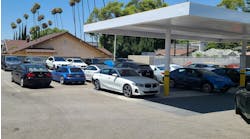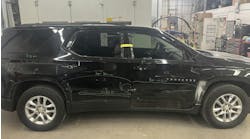With proper maintenance, you can get the most out of your spray booth
The booth has changed over the years from just a box to paint in to a self-contained painting environment, one that regulates airflow, lighting and temperature, and controls dirt contamination. There are attached mixing rooms and vestibules, and there is even talk of paint booths that control or eliminate VOC emissions. Though a significant investment, a properly maintained and efficiently operated paint booth can produce 10 or more paint jobs per day.
Types of booths
Paint booth technology has changed as paint has changed, and paint booth manufacturers have developed equipment to meet modern needs. Some of the first booths used when lacquer was the primary coating were the crossdraft type, generally a simple non-insulated box that had filters at both ends and commonly worked by drawing air in from the rear and exhausting it at the front.
Booths of this type worked primarily to contain overspray and exhaust it to the outside. Lacquer paint dried mainly through evaporation, and a crossdraft booth helped speed up the curing time, though evaporation time before the paint could be buffed (necessary with lacquer paint) was generally 18 to 24 hours.These booths were a significant improvement over spraying vehicles in the shop, and they protected workers outside the spray area from overspray. Crossdraft booths had some significant problems. They drew in massive amounts of air through the rear door, which in the wintertime could significantly lower the shop's temperature and tax the building's heating capability. They also drew massive amounts of air, contaminated with shop debris, across un-cured paint, often depositing dirt as the filters become filled.
Filter technology at this time was crude at best, drawing air through paper arresters (filters). The openings in these paper filters were offset causing the air to change direction and depositing paint mist on the paper as it passed by. Most paint fumes were exhausted out the paint stack. As incoming air quickly contaminated the rear booth filters, it allowed most of the dirt and debris to pass through into the booth. All vehicles painted with lacquer were polished at the time to create the desired shine so small dirt particles were eliminated during the polishing.
The next type of booth that was developed was the semi-downdraft booth. In these booths, air was drawn in from outside, heated as needed and entered the booth through the top at the rear, drawing it down over the vehicle and exhausting it out the front at or near the floor. These booths were an improvement over the simple crossdraft booth because of their ability to heat air while not contaminating the vehicle with shop dirt.
Filter technology also was changing. Newer filters passed air through fiberglass that got progressively finer textured, filtering out much more than paper arresters were ever capable of. Incoming air was cleaned with a pre-filtering and then passed through the ceiling filters, providing much cleaner air in the paint area. The air still traveled from the top rear, passing over the entire vehicle to be exhausted out the lower front, and if any dirt did get in or if there was a leak in the booth, dirt was still drawn over the vehicle, depositing it on fresh paint as it passed by.At this time booths were beginning to be equipped with fans that forced air into the booth, including a second set of fans that drew out the air. Because of the addition of a fan forcing air into the booths, the airflow could be adjusted by forcing in a slightly larger amount of air; then the exhausting fan would draw it out, thus providing a positive airflow in the booths. With more air coming in than going out, if there were a "leak" in the booth it would blow air out rather than sucking air (and dirt) in. Gauges that monitored airflow were installed on the booths that monitored air flow, which changed as filters became clogged. These air balance gauges helped painters maintain proper positive airflow in booths throughout the filter life.
The next generation of paint booths was the downdraft group. These booths had incoming filters completely covering the ceiling, and exhaust filters in the floor that directed the air straight down, passing over a much smaller part of the vehicle. The incoming air, on some, was pre-filtered before it was passed on to the ceiling filter, which eliminated nearly all the dirt and debris before it entered the booth. By pre-filtering the incoming air, the ceiling filter, which had increased in filtering efficiency to the point of eliminating particles as small as 3 microns (micro - one millionth of a meter), would last much longer.
Filters in the floor, the first place paint is filtered, had also become more efficient and could filter out most of the dirt and paint particles before it is passed into the exhaust filters. With the increase of air filtration efficiency and air flow monitoring, it is now more critical that painters control their booths more precisely and regularly. The introduction of basecoat/clearcoat paint decreases the need for polishing. Painters who want cleaner application of paints can no longer just wet down the floor before painting and expect to have a clean paint job. Booth maintenance is now much more critical.
Spray booth operation
As spray booths have become more sophisticated, their operation has become more critical. If operating properly, booths deliver safe and clean applications as well as fast purging and curing of paint systems. So what should a painter do to reap the benefits of a modern booth?
First of all, the booth must be kept as clean as possible. To do this, the technician should never open booth doors unless the fans are running and balanced. That is, the booth should be in a positive air flow, as monitored by its booth air balance meter or magnehelic gauge. When a booth is balanced with positive airflow, it is less likely to draw dirt and debris into the booth when doors are opened. If the booth is balanced with a negative airflow or the booth is off, with the doors open, dust (which is statically charged) will enter the booth. When a positively charged vehicle is placed inside, dust will be drawn to the vehicle.
In the past, painters often would wet the floor, then place a vehicle in the booth and ground it by draping a chain over the axle. This practice was abandoned when painters learned that it caused the booth bottom to rust out. Also,with new downdraft booths, when the floor is wet, it quickly evaporates during the painting process.
Other practices that help keep a booth clean are the application of a separable masking on the booth's walls that can be cleaned off and reapplied as needed, as well as covering the floor with paper that is changed as it gets dirty. Another best practice is never sanding or masking in the booth. All prep work should be done in a prep station or using a vacuum as far away from the paint booth as possible. As much masking as possible should be completed before the vehicle is loaded in the booth, and the booth should be cleaned before each paint job. Though it may be controversial to some, experts recommend that a balanced booth that is generally clean and on be blown clean before the vehicle is loaded. Direct the air stream of the blow gun towards the floor filters so dirt can be trapped there instead of contaminating the vehicle during painting.
The masked vehicle should be blown off with high-pressure air before it is loaded into the booth. The complete vehicle should be blown off, including the masking paper and all cracks where dust can hide. Apply a chemical cleaner just before the booth doors are opened and the vehicle loaded. Many painters believe that the vehicle should be pushed in instead of driven in so as not to contaminate the booth with exhaust. This is wise especially with diesel-powered vehicles.
After the vehicle is in the booth – with the doors closed, the balance checked and the finish masking completed – the vehicle should then be blown off again with low pressure. The surface area to be painted should be cleaned with a final cleaner, most of which now contain an anti-static component such as alcohol to help eliminate any static that may have built during preparation. Finally, just before spraying, the vehicle is tacked. (The tacking process is a good time for the technician to give the vehicle a final inspection before spraying.)
An often overlooked tip for keeping a vehicle clean while it is being painted is to limit access to the booth. No one without a paint suit should be allowed in, and the painter should make the least number of necessary trips into the booth. It is best to mix all the coatings that will be needed, take them into the booth and paint the vehicle. The fewer times the door is opened, the less likely dirt will enter. If the booth is equipped with a mixing room, no one should enter the booth except through the mixing room access door. Booths equipped with a vestibule (a small room that painters go into to clean up and suit up before going into the mixing room) significantly reduce dirt in the paint. Painted floors, which are easier to clean, also cut down on dirt in paint.
Filters
Filters come in many different types, configurations and price ranges. They can be very inefficient, such as paper arresters or some fiberglass filters which only trap large particles and become clogged very fast. Though denser filters cost more, they are also more efficient and trap more particles, allowing other more expensive filters to last longer. Pre-filters and exhaust filters are generally made from the denser filter media and in a "pillow" configuration. This allows for a larger surface area, making this configuration markedly more efficient. Ceiling filters are the most dense and costly; for this reason, many booths now use pre-filters to clean air before it is passed through the ceiling filter, extending its life significantly. With filters, often a more expensive filter may last much longer and do a better job of keeping the vehicle clean, so it would be well worth the investment and higher price.
A question the painter may ask is, "When should I change my filters? Is it monthly, or maybe every five paint jobs, or should they be changed when they look dirty?" The answer lies with the booth air balance meter. As filters become clogged, the flow of air through them becomes more difficult. When this happens, the booth's balance changes, and eventually the booth can no longer be balanced. On the booth control panel, along with controls for the temperature and time, is a balance control knob that is used to balance the booth in both positive and negative directions.
When the booth can no longer be balanced, filters should be checked. Start first with the floor filters. If, after they have been changed, the booth will not balance, the exhaust and pre-filters should be checked. Ceiling filters are changed less frequently but should still be periodically checked. If all the filters have been changed except for the ceiling filter and the booth will not balance, then the ceiling filter too should be changed.
Don't judge filters solely by their appearance. Often a fresh white filter in the floor will look dark and dirty after a black vehicle has been refinished.
Check the precise amount of airflow in a booth from time to time. The booth airflow should be nearly the same at all four corners of the vehicle. Also, technicians should know that the airflow of a loaded booth will be higher than the airflow of an empty booth. Knowing the exact amount of airflow of your booth will become critical when waterborne paint is applied. A significantly higher amount of airflow is needed to evaporate waterborne basecoats.
Conclusion
In a busy shop it may seem that performing maintenance on the booth should be the last thing on a painter's mind. But proper maintenance saves time in the long run. You have a choice. You can dedicate a relatively small amount of time to cleaning the booth properly and maintaining good airflow by using more efficient, higher quality filters that you monitor and maintain regularly. Or, you can perform dirty paintwork that takes much longer to detail for delivery. An efficient shop will develop a paint maintenance standard operating procedure that can be completed regularly. Whether the maintenance is done by the painter or assigned to a painter's helper, the results are well worth the time spent.




